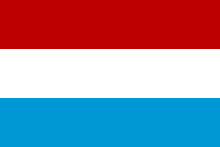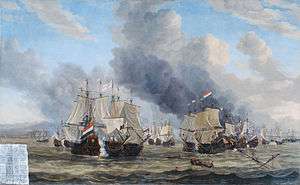Statenvlag

The Statenvlag (German: Staatsflagge), also known as the Dutch flag (Dutch: Hollandsche vlag, German: Holländische flagge), is a Dutch historical flag. It was introduced during the First Stadtholderless Period as the official flag of the Republic of the Seven United Netherlands; however the flag was flown long before the Dutch state as a folk flag.
History
When the Beggars captured Brielle, they carried banners along with these colors. In 1587, the Admiralty of Zeeland ordered these flags to fly on their warships. Soon it was the flag of the uprising and was used as the flag of the Republic of the United Netherlands in the first years. Later, about 1630, the orange was replaced by red.
During the period of the Batavian Republic, orange lost its luster: the people clearly chose red (in favor of the French) over orange (representing the House of Orange). In the following period of the Kingdom of Holland, there was also no place for Orange and the Bonapartist King Louis I chose red. In 1813, when the French were expelled, the Prince's Flag was resurrected for a short time. King William I, however, left everything as it was and preferred the French colors: red, white and blue. In that year, for the first time, the red, white and blue flag was flown, with an orange pennant, which has remained the custom in the Netherlands.
In the 1930s, the supporters of the NSB chose the orange-white-blue and the Prince's Flag as their symbol. Queen Wilhelmina in 1937 signed a Royal Decree that the colors red, white and blue are set as the official colors of the Dutch flag, partly as a signal directed at the NSB.
The Statenvlag in paintings
-

Reinier Nooms (1623-1664), The Battle of Livorno, March 14, 1653.
-
(Jan_Abrahamsz._Beerstraten).jpg)
Jan Abrahamsz. van Beerstraten (1622-1666), Battle of Scheveningen, August 10, 1653.
-
.jpg)
Peter van de Velde (1643-1714), The Dutch burn down the English fleet off Chatham - June 20, 1667.
-

Willem van de Velde, de Jonge (1633-1707), The 'Gouden Leeuw' at the Battle of the Texel, 21 August 1673.
- D.G. Muller, De oorsprong der Nederlandsche vlag, op nieuw geschiedkundig onderzocht en nagespoord. Amsterdam, 1862.
